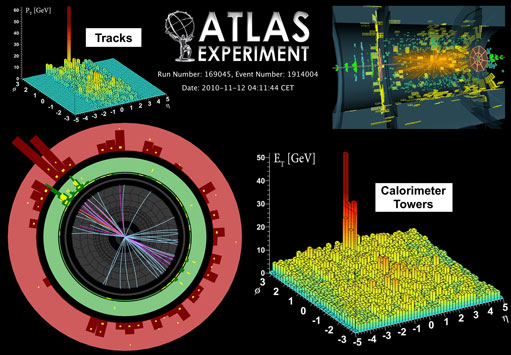
ATLAS e-News
23 February 2011
Jet quenching: Easy to spot, harder to prove
30 November 2010

After less than three weeks of heavy-ion running, ATLAS has reported a dramatic effect that causes an unexpectedly large imbalance of energy for jets created in the lead ion collisions. Similar effects were confirmed by the other LHC experiments. Similar effects were since seen also by CMS.
Being the first LHC experiment to report this observation also greatly contributes to the general pride shared by all those involved. The ATLAS result was accepted for publication at record speed by Physical Review Letters on Friday, November 26 and will be presented at a CERN seminar on 2 December.
All those involved, senior researchers and graduate students alike, were taken by surprise. As Brian Cole says: “The minute we started analyzing the events, we knew something striking was happening”. But as Martin Spousta explains: “I would never have expected that we could see the influence of the medium on jets just by eye in the event display“, a feeling shared by Martin Rybar, a graduate student working on heavy ion collisions: “I expected some small effect of jet modification that we would be able to see after a long analysis so I was totally surprised to see it just on event displays.”
Aaron Angerami, another graduate student enthusiastically adds: “… We can [now] aim a lot higher about being able to provide quantitative answers to questions about jet energy loss and the quark-gluon plasma as a whole. The game is totally different from what it was two weeks ago. We have a chance to gain a much deeper understanding of the physics.”
This was just the beginning, as Martin Spousta explains: “The most exciting part for me was to try to find out how to quantify the effect that was clearly visible by eye and how to precisely measure it.”
But if these events were hard to miss, quantifying the effect was another story.
And that's were the phrase “ATLAS collaboration” took all its meaning. As Peter Steinberg, the Heavy Ion group co-convener, describes it: “Besides the physics, […] the most exciting part of this process for me was working alongside so many amazing ATLAS colleagues. As soon as the collaboration realized that the effect was appearing, experts on the detector, reconstruction, and physics analysis immediately made huge, essential contributions: both to make sure that the data was of the needed high quality and to make sure nothing was being overlooked. This was particularly important since we had no well-established physics models to compare with our data.”
And Leandro Nisati, ATLAS Physics Coordinator, emphasizes it even more: “This result has been possible thanks to the amazing effort and cooperation produced by ATLAS in all the areas of the experiment. The analysis has involved not only the small but outstanding Heavy Ion team that led the analysis, but also many young physicists experienced in proton-proton physics who played a crucial role in proving the physics effect we observed in our Pb+Pb data.”
Many young jet, simulation and tracking experts were called into play. One of them was Zachary Marshall. As Zach explains: “I was asked by Kevin Einsweiler [the Standard Model group co-convener] to help take a look at the jets in these events and see if there was anything fishy going on. The heavy ion guys haven't spent as much time staring at calorimeter variables as we have, so I tried to help them understand and check those variables.”
Seth Zenz and David Miller were also called in as "track jets" experts, being able to study hadronic jets using the Inner Detector. As Seth recalls: “David and I, […] along with Zach, looked at [tracks] in the HI events to cross-check the calorimeter results, producing an independent study of the asymmetry in track jets as well as confirming the quality of the calorimeter jets in the main measurement.” But being nine time zones away from CERN had its good and bad points, as Seth explains: “Usually two, and often all three of us, were awake and meeting continuously on Skype from Saturday to Wednesday. The major challenge was technical: getting the information we needed out of the data formats we had quickly enough. Our contribution got three sentences in the paper, which actually seems pretty exciting for four or five hectic days' work!
Zach adds: “It was really exciting to know that everybody was watching and scrutinizing the work. It certainly made me extra-critical of every plot that David, Seth, or I made, knowing that we couldn't afford much time for getting things wrong and that if we did significantly screw up a cross-check, it could potentially jeopardize the paper!”
Eric Feng is another jet expert who received the 'special call': “A couple weeks ago, I received an urgent email from one of the Jet/EtMiss group conveners, Tancredi Carli, who basically asked me to drop whatever I was doing and look at the 'monojet' events in the lead ion data ASAP. We used jet measurements in proton-proton data as a "standard candle", which was critical in order to convince ourselves that the jet quenching we observed in the lead ion collisions was real”, he explains.
The same proud feeling could be heard from all those interviewed. Translated in Leandro's words, it goes as “I'm very proud of this result, and to serve this fantastic experiment!” or, as Zach puts it, more jokingly: “There was also some great pleasure in being first.”

Pauline Gagnon
|